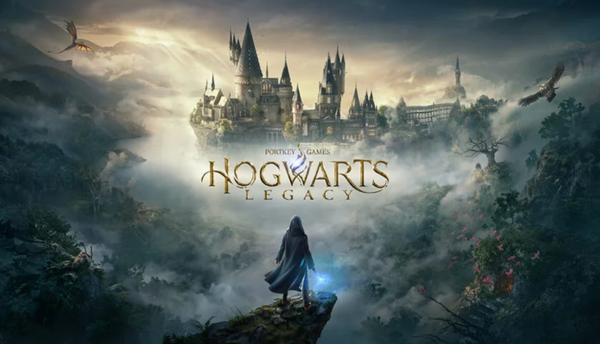In video games, the “live service game” is ascendant. That’s a clumsy industry term classifying games with no proper ending. Programmers keep updating titles like Fortnite, Call of Duty, and League of Legends in perpetuity to addict their players—extracting their money and data along the way. Indeed, the internet-at-large’s attention economy operates in the same fashion, but games manage to hook their users with ruthless efficiency. Half of millennials and Gen-Zers are glued to them for at least eight hours a week, and predatory “microtransactions” in popular live service games are now a $67 billion industry.
So naturally, Gamergate—video games’ marquee scandal—works in much the same way. The idiosyncratic controversy that first galvanized the internet in 2014 is a live service culture war that never dies. This, in any case, is one way to look at the raucous culture-war battle currently being waged in 2023 over author J.K. Rowling’s ties to Hogwarts Legacy. The new Harry Potter-themed adventure game is the biggest video game of 2023, despite a vociferous boycott by pro-transgender activists and progressive-leaning gaming journalists incensed about what they imagine is Rowling’s “transphobia.”
Liberal tech sites have either condemned Hogwarts Legacy or tiptoed around its existence. Wired scored the game a 1 out of 10, calling it “as heartless as its creator.” Vice’s gaming vertical, Waypoint, last mentioned Hogwarts Legacy almost a year ago, as if covering the game could summon Voldemort. Other reviewers felt compelled to issue tortured apologies in advance of reviewing the game (“I’m a bisexual woman, and I have a big ol’ Harry Potter tattoo next to an anti-TERF tattoo,” proclaimed an Engadget writer). Meanwhile, transgender activists keep harassing Rowling and online streamers who play Hogwarts Legacy on Twitch. Strangely enough, Vogue emerged as one of the only publications to decry the death and rape threats directed against Rowling.
What the media fail to mention is that we have seen this all before: a loose alliance of like-minded social media users who channel their hatred for a woman in the entertainment industry into an online harassment campaign and boycotts of her video game. This was how Gamergate began nine years ago—only with the roles reversed.
In 2014, an amorphous group of gamers—convinced that their hobby was getting too woke—sketched out a vast conspiracy between a clubby bunch of coastal video-game journalists, indie game developer Zoe Quinn, and feminist critic Anita Sarkeesian. They harnessed the power of 4Chan and sympathetic right-wing sites like Breitbart and banded together to harass, belittle, and boycott their perceived enemies.
In some ways, Gamergate was like Russiagate for comic-book conventioneers—a complicated morass with a large cast of characters that was impossible for the layperson to follow. The difference is that Gamergate never had anyone like Bill Barr. The closest thing to an even-handed account is David Auerbach’s series of explainers for Slate back in 2014.
Its slipperiness helped make it the perfect scandal for the social-media age; an asynchronous pseudo-event without apparent crimes, stakes, or goals that could be repackaged and reified as an easily digestible black-and-white narrative with heroes and villains.
“Everyone bought shares in Gamergate.”
Everyone bought shares in Gamergate. Former Donald Trump adviser Steve Bannon saw it as a recruiting opportunity. He tried to capitalize on angry gamers, theorizing that the puzzling figure of Milo Yiannopoulos could red-pill “rootless white males” and transform them into an army of what would later be called the “alt-right,” with “alt” seemingly meaning Very Online.
Democrats and the liberal media also propped up Gamergate, turning it into a bewildering boogeyman, an origin story for right-wing populism and the MAGA movement. Trump was the “Gamergate” of Republican politics, asserted The Washington Post, with Jan. 6 serving as a gamers’ coup of the federal government. “There is a direct line from the game industry and media’s failure in addressing Gamergate to the right-wing terrorism we’re seeing today. Period,” tweeted Shayna Moon, a producer for Sony, on Jan. 6.
In 2019, The New York Times topped a way-too-solemn fifth-anniversary section for GamerGate with an essay titled “Everything Is Gamergate” that concluded: “The lesson of Gamergate is that there’s a sinister power afforded to those brazen enough to construct their own false realities and foist them on others.”
There’s something to that analysis, but the Times’s framing suggested this lesson revealed only a right-wing problem, with noble liberals the last defenders of the Truth. But as Angela Nagle wrote in Kill All Normies, her 2017 account of the online culture wars, “both sides have become increasingly unmoored to any cultural mainstream.”
Gamergate’s ultimate legacy is symbolic. It marked the moment when two sets of avatars—one side woke, one “based”—broke free from the fringe corners of the internet and flooded the mainstream. For those on the outside looking in, Gamergate felt jarring and deeply stupid. Yet nine years later, it’s clear that these dueling yin-and-yang forces—the identity politics-obsessed left and let’s-trigger-the-libs right—are flourishing both online and off, as if those distinctions even matter anymore.
Sorry, normies, there is no such thing as game over—just a narrative that never stops evolving and reinventing itself, a steady drip feed of new content to download and consume for eternity.
